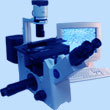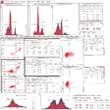
Methods of Investigation
for FP7 partners
and coordinators
|
|||
| Home | |||
| Cytotechnology Group | |||
| Staff | |||
| Methods | |||
| Projects | |||
| Research Results | |||
| Patents | |||
| Image Gallery | |||
| Cooperation | |||
| Contact Us | |||
Influences of Gradient Laser Fields on Microobjects |
|
A particle placed in the light field with spatial gradient of intensity along the z-axis is subjected to action by a gradient dipole force along this axis and draw in microobject into maximum of spatial gradient.
We have demonstrated for the first time that the application of gradient laser field to peripheral blood lymphocytes as compared to illumination with spatially uniform laser radiation activates some protective repair mechanisms leading to a considerable decrease of apoptotic cells and an increase of cell viability. Orientation of cells using gradient laser field keeps off large afunctional cell clusters that are disposed to apoptosis, thus increasing vital cell fraction up to over than 80% after cells immobilization, provided some chemical stimuli used. Rubinov (2002) has proposed another mechanism for the explanation of the biological activity of laser radiation, which does not require participation of specific absorbing photoreceptors and in which the coherence of laser radiation is the most important factor. According to this concept the primary action of laser light on a biological system is not connected with absorption of light quanta, but with the action of so called dipole gradient forces. Such forces appear during the interaction of an object with spatially modulated light. In case of coherent illumination of an object the spatial modulation of light intensity originates from interference of the incident beam with the light beams reflected and scattered by the object, in this case the body tissue. As a result the speckle structure of micrometer scale with strong intensity gradients appear on a surface and in a bulk of the illuminated object. It must be noted that such structures are not formed during illumination of body tissue with incoherent light sources. So the primary step of the biological action of laser light is considered to be the action of gradient forces due to the non-resonant dipole interaction of the electrical component of light with the light-induced electrical dipole moment of biological microparticles (organelles, cells and their aggregates). No absorption of light quanta is involved in this process. Apart from speckles, which automatically appear at laser irradiation of body tissue, the gradient laser fields can be created purposely by using one or other scheme of laser beam interference. It allows to perform exact controls and to vary the spatial structure of a laser field at an object illumination. The action of gradient fields is expected to cause several biological effects in body tissue (Rubinov, 2002):
All these phenomena may significantly influence the function of individual biological systems as well as of an organism as a whole. In particular, the following effects are expected: influence on blood cells, improvement of enzyme activity, stimulation of the cell cycle and stabilization of the proliferation-apoptosis balance. Related info in ISTC Project #B-479 The technique described above was used in LBMI when performing the research project ‘To work out and validate the implant plate for growing and transplanting cells for clinical use in the treatment of hepato-cellular deficiency and diabetes mellitus’ (Project Chairman - Vitaly Goranov)
|
| COOPERATION NEWS | ||
FP7 Programme involves subjects
|
||
| CURRENT RESEARCH | ||
|
||
| 2005-2007 © LBMI |




